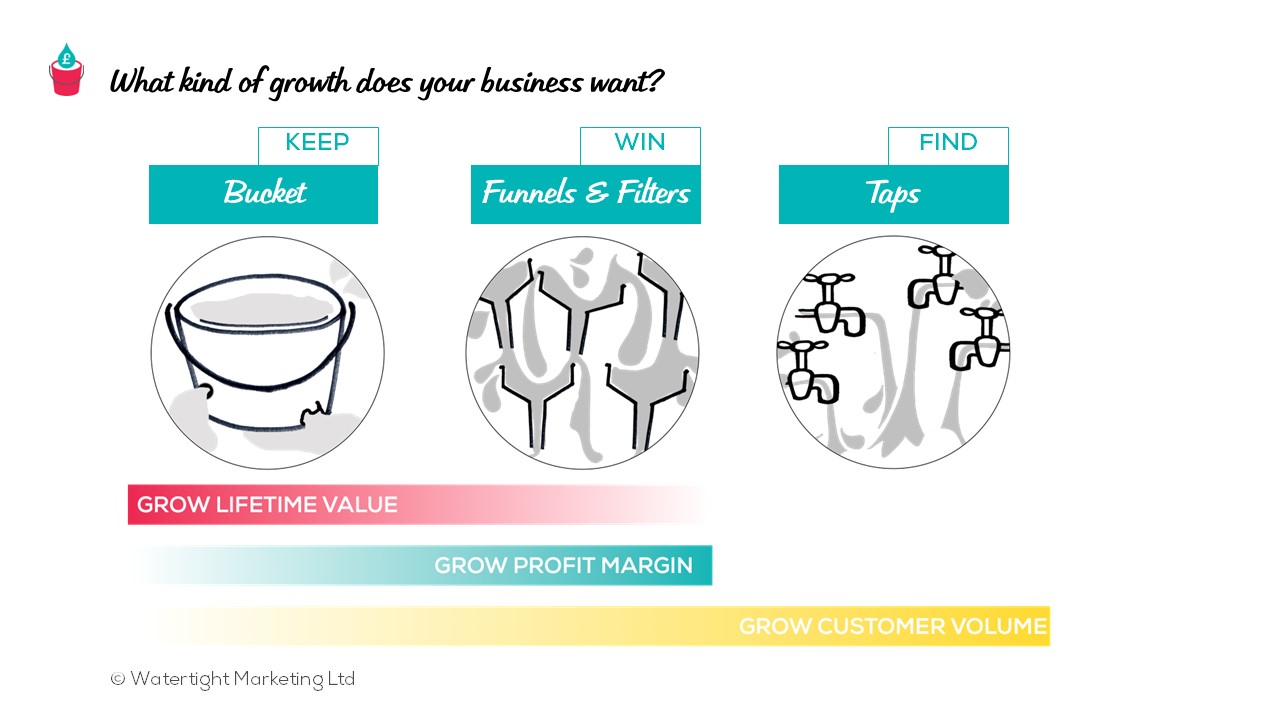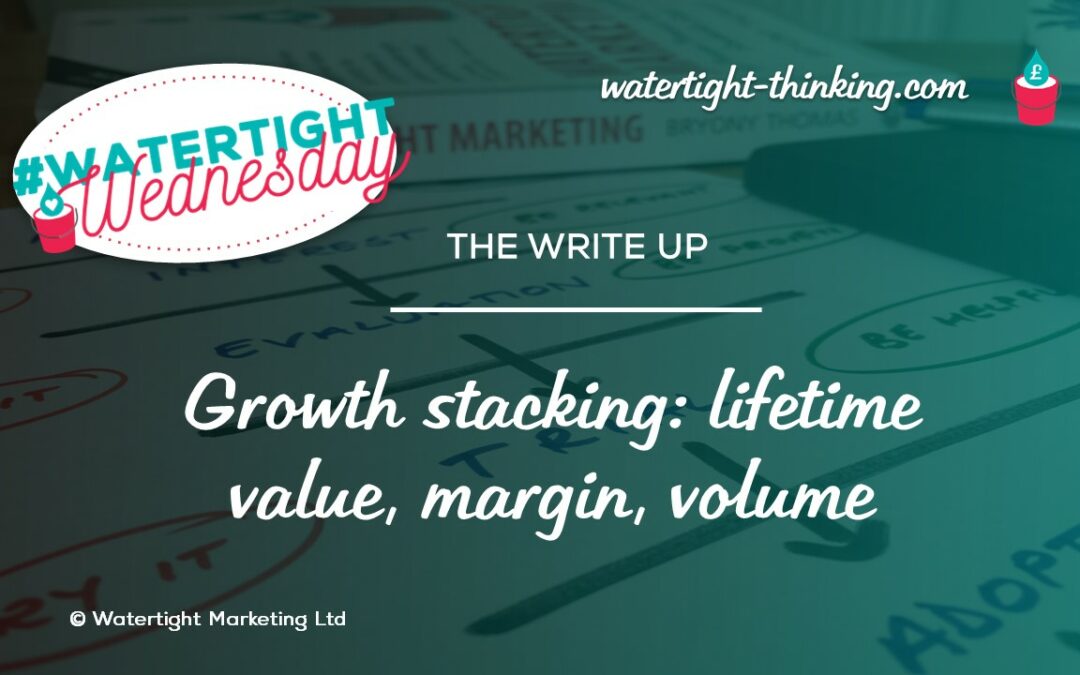Reading Time: 10 Minutes
“Marketers are often asked to generate more leads in response to a business growth goal. This is volume growth, but it’s not always the kind of growth you need or want. In fact, marketing (working closely with customer service and sales) can support different kinds of growth – existing customers, warm prospects as well as engaging with the right prospects.” ~ Rachael Wheatley, Managing Director | Watertight Business Thinking
Listen to the session podcast here
55 -minute roundtable discussion on how marketing supports sales: volume, margin and lifetime value
Rachael kicked things off by asking this question: what kind of growth does your business want? There was a real mixture of responses including:
- Maximum 15% growth in the number of clients (we don’t have capacity for more);
- Dispersing the effort and de-risking – ensuring all our eggs are not in one basket (volume);
- More from existing clients and increasing life-time value;
- Improve profitability and margins alongside delivering value for customers.
Broadly speaking, there are three different kinds of growth aligned with finding, winning or keeping customers. You might focus on one or a mix.

There are also different marketing tools and techniques you’d use to support each type of growth:
To build loyalty, deepen relationships and encourage your customers to buy more and stay longer, think:
- Welcome packs and helping new customers to get the value from what they’re buying;
- Creating an emotional connection at that point when they’re saying ‘yes’;
- Regular communications such as newsletters or personal emails with relevant content;
- Account management: calls, check-ins, service reviews;
- Customer-only offers or events;
- Content that’s relevant, interesting and valuable to them;
- Early access to new products or services
- Thank you or celebration gifts.
Activities that sit alongside your sales function, support them, make their life easier and help to improve margin:
- Any tool that filters out the wrong kind of work or client and so increases the ratio of people moving on (a quiz, an assessment);
- An event that gives them an introduction to what you do;
- An initial, smaller paid gateway product they can try before moving on to the bigger version;
- Deeper content that showcases your expertise and knowledge and around which topics sales people can have conversations with prospects;
- A buyers guide that speaks to those voices of veto – people who can say no – and what’s on their agenda.
- Marketing that proves what you’re promising and evidences you’re as wonderful as say you are.
And finally, marketing that will support volume growth includes:
- Tools that help to attracts and engage the right customers and more of them;
- Activities that often cost money for every minute you run them – adverts, PPC;
- Sponsorships and exhibitions;
- Website and landing pages;
- Blogs and articles;
- Social media posting.
Why starting from the bottom up has more impact
We walked through a case study which showed why a taps (top) down approach doesn’t have as much impact as a bucket (bottom up) approach (see Chapter 10 of Watertight Marketing).
You could increase volume (what you can count), however if instead you first improved the movement metric (which shows progression in the decision journey) you’ll get a far better uplift in revenue. Layer on top of that your ‘leak tweaking’ – plugging your marketing gaps and improving leaks from the bottom up – and you start to see the more dramatic effect of compound interest.
In other words, grow your life-time value first, followed by margin before considering how to grow volume. If you’re being asked to ‘grow by 10%’ it’s worth interrogating what is meant: is it the number of customers, the amount they spend with you, the margin you make on products or services or something else? And don’t be afraid to challenge any assumptions – for instance, volume growth isn’t necessarily what’s best, quickest or easiest for the business.
Creating long-term relationships with customers is the starting point
Peter Baynes kicked off the discussion: “A trusting, mutually-beneficial relationship with a customer protects our position and is hard to replicate. We need to provide best value to the customer, keep in touch and look out for other of our products or services that are relevant.
“That said, if your business sells something which is an impulse buy or one-off transaction, you do need a constant stream of new customers. That comes from satisfying existing customers – it’s a pre-requisite to being able to win more.
“I’ve found that where there’s more of a sales focus in a company, they ask for more leads. There’s been an increasing focus recently on existing customers, how we maintain relationships with them to deliver more profit and value to them. This shift in focus moves marketing to being about delivering customer value, not generating leads. That’s where Watertight Marketing is spot on, because it focuses on delivering that value.”
Cheryl Crichton: “It’s no surprise that in all the years we’ve been running our Touchpoint Leaks Assessment, the leak that comes top time and again is the first one, Forgotten Customers. I’d add two things: you need to have a really good handle on who your customers are, the data and processes or tools to easily keep in touch. Secondly ensure you offer something unique and valuable to your customers first before going out to the rest of the world; it makes them feel special.”
Rachael Wheatley: “And you can co-create new products and services with existing clients. That can be hugely valuable – you get early road-testing with your ideal customers and they get additional value too.”
What kind of marketing works and how you measure success
Venetia Price: “I work in B2B telecoms and we have two main audiences: direct to other businesses and wholesale/resellers. On the reseller side, their pain point is lack of marketing resource and support, so we’ve been focusing on helping them to cross-sell. We’ve been doing surveys to get feedback on how we’re doing on service, support, how our products are performing and any improvements we can make. And we have account managers who go out and speak with resellers. In terms of new business, what’s working for us is sponsoring very specific events and in return we get 15 minutes with warm prospects – a bit like speed dating.”
Rachael Wheatley: “It sounds like the focus is on lifetime value – how is that measured?”
Venetia Price: “I’d love to do that but marketing is in its infancy here so we’re taking one step at a time.”
Rachael Wheatley: “And actually without that data to show the metrics, it’s really hard to deliver the kind of growth you’re being asked to support.”
Peter Baynes: “It does come down to measurement. Not having the data on customer lifetime value can happen because the focus is on generating new leads or volume.”
It is curious how often marketers are associated with (or asked to deliver) on lead generation. For sure, it’s an element of marketing, but it doesn’t represent all of it.
Cheryl Crichton: “One of the reasons why marketers are often asked to focus on volume growth is because that’s what we’re perceived as doing, that’s our job.”
Rachael Wheatley: “Another is because volume growth is often seen as quicker – and that’s what businesses want sometimes. However, the risk is that you don’t always get the right clients and they don’t stay.”
Venetia Price: “Having the right client is key. But it doesn’t always work like that. So what I’ve been trying to do is use the cross-selling piece to offset churn.”
Peter Baynes: “And, coming back to metrics, the measurement for existing relationships are profitability, lifetime value and churn. That will be the last thing the sales director will typically look at and that’s a real frustration for me. Keeping and serving customers well is surely easier than generating new customers!”
Laura Page: “Historically we had quite a low acquisition cost so we focused on filling up from the top but there was a lot of waste in the process. Over the last couple of years we’ve looked at reducing cancellations and making more of the opportunities that come in. We’re back looking at volume again and we’re in a better place in terms of what leaks out. Because we’re an impulse and often one-off purchase, we need a big volume of new customers every day. So for us, we want to know which marketing channels make the best conversions. That guides where we get more volume from, reduces acquisition cost and improves profitability.”
Lack of good data holds you back
Laura Page continued: “We don’t know how many existing customers would buy again or how frequently. A good CRM system is one of the things we need to get in place. And we want to know more about when we get referrals, when people buy because of our brand rather than just because we’re top of a Google search.”
Rachael Wheatley: “I can’t help wondering if you had that data, it would help you to develop products and services that would help retain your customers and encourage them to come back and buy more or again.”
Laura Page: “I’m absolutely sure it would! We do get customers who come for an emergency and then go on to purchase one of our more routine services that people do get done every year. But we don’t have the data to encourage that. With that data, we’d also reduce the acquisition cost because at the moment that’s only measured using their first purchase.”
Rachael Wheatley: “Data has come up several times in our discussion. My experience is that that can sometimes be really hard to get. And without that, it’s difficult to challenge received wisdom (generate more leads).”
Peter Baynes: “It’s a lot harder to get data and insight on existing customers; much easier to get metrics on number of new enquiries or web visits.”
Kerry Turney: “The business that I work for, managed IT services, we seem to be very good at increasing lifetime value. Looking at the metrics, with the IT industry it was very much referral-based, so people would come in at the Trial phase, already knowing a bit about us. That’s not as strong now, hence why I’m in the business and we’re focusing on finding customers using our website and social media. Because we haven’t done that before, we have no metrics at all.”
Rachael Wheatley: “What is possible, being a small company, is build those metrics up manually, anecdotally.”
If your manager or the Board are tasking you with one kind of growth, but you believe it’s more profitable and effective to start somewhere else, having the data can help you to build your case.
Peter Baynes: “I’ve definitely seen that, where a company wanted leads and I said, give me your customer list and we’ll uncover some real opportunities. There was a lot of push back, but then they realised the value of talking to their customers.”
Right people in the roles
It’s important to ensure that the right people are leading on the different kinds of growth. Whilst the marketing team can support all three types of growth with different tools, it might be that because of their aptitude and skills, sales people lead on the funnels and service people take a lead with existing customers, both with the objective of growth (margin and life-time value respectively).
See our roundtable from last month: Creating seamless marketing, sales and service teams or listen to the podcast here.
New business and sales is often seen as the more exhilarating bit of growth.
Peter Baynes: “It’s more exciting to get new customers than look after existing customers; the processes around developing relationships with clients is harder and involves more.”
Cheryl Crichton: “That depends on who you’re talking to. I spent a lot of time working in client services and to me it was much more interesting and exciting getting repeat business from existing customers. So it’s a bit of a personality thing – some people will like sales or marketing or service more because it fits with their approach and skills.”
Cheryl continued: “If you have a small team, it can be damaging to put someone in a role they didn’t join the company for or don’t want to do. So you do need to know the strengths of each person.”
Rachael Wheatley: “Yes, I can see how you might ask, for instance, customer services people to perform a quasi-sales role which they might not feel comfortable with. Though of course you can train people so they do feel more comfortable.”
Peter Baynes: “The beauty of Watertight Marketing approach is that it enables you to communicate what marketing is and the role they play in it. I’ve been involved a lot of technical companies where it’s a consultative sell and it’s the subject matter expert who is the account manager. They’re not necessarily relationship people, but the Watertight approach can help them develop a BD mindset and where it fits it, and so they can become better relationship-builders and business developers.”
Watertight Wisdom
What’s worked for us
Ideas from around the room about how to support growth:
- Agree your focus – whether that’s volume, margin or life-time value, in conversation with your team and the wider business, preferably based on data. Then build out your marketing to support that.
- Use our assessments to determine where your marketing gaps are – this can identify, for instance, whether it’s worth going for volume or margin if you have a leaky bucket!
- Challenge assumptions – one kind of growth isn’t necessarily what’s best, quickest or easiest for the business.
- Use data to build your case – if you’re challenging assumptions, use existing data or walk colleagues through different scenarios to help get buy-in to a different strategy.
- Have a robust conversation about strategy – it’s not just what business we’re in but what markets we’re in; to get that strategic growth ask, how do we deliver value to those customers in the markets we want to be in. That helps get away from the short-termism of lead generation.
- Start with existing customers – data might be harder to get, but starting here is easier, costs less and is more profitable in the long-term. There’s no point in having more customers if they don’t stay long or you’re not building relationships with them.
- Decide what and how to measure volume and progress – you’ll first need to determine what ‘success’ is. It’s not just about what you can count, it’s also about checking that the right prospects are moving towards buying from you.
- Right people in the right roles – play to strengths, but do consider training and development where needed so they can actively support growth goals.
What would you add to our list? Do let us know your thoughts.
To join the conversation at our next Watertight Wednesday marketing roundtable you can sign up here. Next time we’ll be having a chin-wag on what a business leader needs to know about marketing.

Rachael Wheatley
Managing Director, Watertight Thinking
Rachael brings over 30 years’ of marketing experience, with a particular focus on building and developing effective marketing teams that are able to act as a strategic driving force across an organisation. She has worked with Watertight since 2014 as a Master Practitioner and joined the business as MD in 2022.



